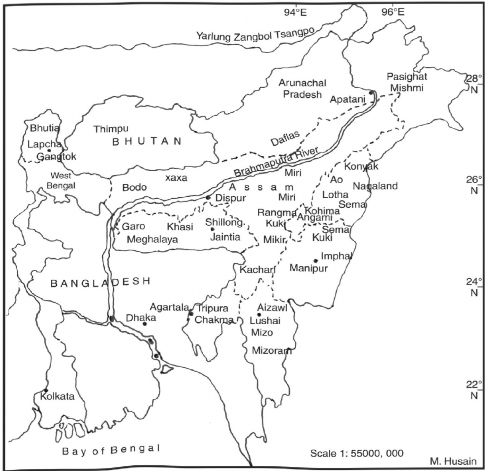The Santhals
Having a population of over 6 millions, the santhals constitute one of the largest tribal groups in India. The anthropological evidence confirms their Dravidian origin which is corroborated by their Austric language (Santhali language and Col Chika script). The Santhal scholars claim that it was the santhals who had developed the Indus Valley Civilisation. The geographical distribution of the Santhals has been shown in Fig. 13.9.
It may be seen from Fig. 13.9 that their present habitat is mainly in the Rajmahal Hills and Cholanagpur Plateau in the state of Bihar, Jharkhand, Odisha, and West Bengal. Tripura also has the Santhal Tribes and they can also be found working in tea gardens of Assam and West Bengal. They are a dominant majority in Santhal Pargana, Giridih, Bankura, Bardhaman, and Birbhum while in more than 16 districts they have a majority. Their demographic growth is about 1.75 per cent per annum.
The Santhals are basically agriculturists (68%). They own landed property and hardly any Santhali is landless. Their subsidiary occupations include hunting, fishing, and collecting forest products. With increasing literacy and cultural contacts, they are also engaged in service, trade and contracting business. Their demand is for a Greater Jharkhand which extends over the Santhal areas in West Bengal and Odisha.
The Santhals have a great cultural heritage and have a w ell defined social order. Widow remarriage is permissible. The Santhal society is patriarchal. The Santhal woman is deemed a strong labour force and contributes to the family income. She participates in the agricultural operations ami decorates her house
before the Bandana festival.
The Santhals live in permanent settlements. The village settlement generally has a rectangular plan and houses are arranged along the main street of the village. They have their own Panchayats and a well developed penal system.
Karma is the only festival of the women in the month of Bhadon. It takes place in Manjhithan girls with music and dance with unmarried girls participating. Their other important festivals are Bandhan or Sohrai (in winter after harvest).
has a cold winter and moderately hot and humid summer. They have adopted English as the official language of Nagaland. It has helped their cultural and political unification.
Their villages are located at the top of ridges for reasons of security. They use hill slopes for terraced cultivation. Where the development of terraces is difficult, they practice shifting cultivation.
The village has a Morung (communal dormitory) for the bachelors, where both boys and girls slay at night. It functions as a youth club where the youths are initiated into tribal traditions and art of community living. They also receive sex education and often their pre-marital sex relations consummate in marriage with the consent of the village community.
The Nagas are by and large agriculturists (85%). They practice Jhuming (shifting cultivation). The Angami tribe around Kohima has developed beautiful terraces for paddy cultivation. They grow rice, pulses, coarse cereals, vegetables and cotton.The Nagas are known for their artistic handicrafts, particularly weaving and wood carving.

Fig. 13.10 North-East India—Major Tribes
doctrine of purity and pollution.
The anthropological evidence suggest their varied origin from an admixture of aboriginal/tribal population with the successive waves of invaders.
According to the Census 2001, the population of Scheduled Castes in India was 66,636 million accounting for 16.20 per cent of the total population, while that of the Scheduled Tribes population was 8.20 per cent. They constitute the socially and economically deprived caste group of the Indian society. They consist mainly of agricultural labourers, marginal cultivators, artisans, landless labourers, and industrial workers. They include the Malls of Andhra Pradesh, the Meghs
of Gujarat, the Mahars of Maharashtra, the Adi-Davidas of Tamil Nadu, the Chamars of Uttar Pradesh and Uttarakhand, and Balais of West Bengal.
